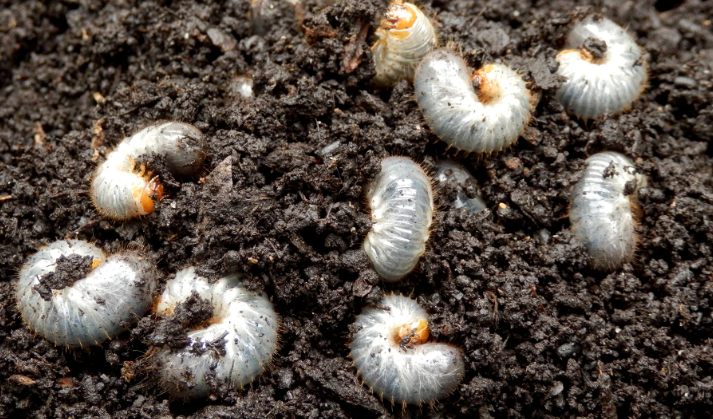As the snow melts off and winter-thin animals emerge from their hibernation you may notice chunks of dead sod flipped over on your lawn and a real mess as skunks, racoons, and other animals dig for fat grubs to eat. This can be a bit panic-inducing. “What’s happening to my lawn? What can I do to stop the damage? And how do I repair it?” Here is a simple step-by-step guide to understand what is happening and how to fix it.

April
At this point the grubs are in month 10 of their annual life cycle, so you can’t kill them at this point. They’re no longer actively feeding on the roots, and animals are feeding on them. The grubs damaged the roots of your grass the previous year, and now the animals are exposing that damage by digging for the grubs in the loose sod. At this point the best thing to do is rake off the dead sod debris and dispose of this in preparation for planting new grass seed when the weather gets warm enough. If you need help with this, we can do this as part of our Spring Cleanup Package.
May
Grubs are now in month 11 of their life cycle and are almost ready to take flight. As temperatures rise to the optimum reseeding temperature (between 15 and 25 Celsius) now is the time for reseeding your lawn with fresh soil and seed. We can help with this step by providing one of our topdressing packages, which includes seed, soil, delivery, and labour to spread the soil and seed and rake it in. We’d then send you detailed watering instructions at this point to ensure best results.
June
Grubs are adults and take flight, leaving eggs behind in the soil. As part of our Pest Control Package, we would be treating for chinch bugs with Biotitan (an organic, non-toxic pest control product) at this point. While Biotitan is primarily targeted against the other troublesome lawn pest chinch bugs, it is also effective against grubs and stays in the soil for several weeks so this will help to reduce the grub population as the new grubs hatch.
July
New grub larvae are hatching. As the second part of our Pest Control Package we would be applying Grub Exterminator, which introduces a microorganism into the soil that is the natural parasite of the grub larvae. These enter and kill the grubs before they can mature. This product is organic and non-toxic and achieves about 60% efficacy of killing the grubs upon first application. Combined with the Biotitan treatment in June, this will reduce their population to a manageable level. A healthy lawn can sustain a few grubs.
September
5) September. As temperatures cool back down to the 15-25 Celsius range this is a great time to do any further lawn repair that might be needed such as overseeding or fertilizing to thicken up the recently-repaired lawn. We offer this in our Lawn Care Package.
Future Years
As they say, an ounce of prevention is worth a pound of cure. It would be advisable to continue the Pest Control Package in subsequent years to further reduce the grub population and prevent future infestations and damage.

